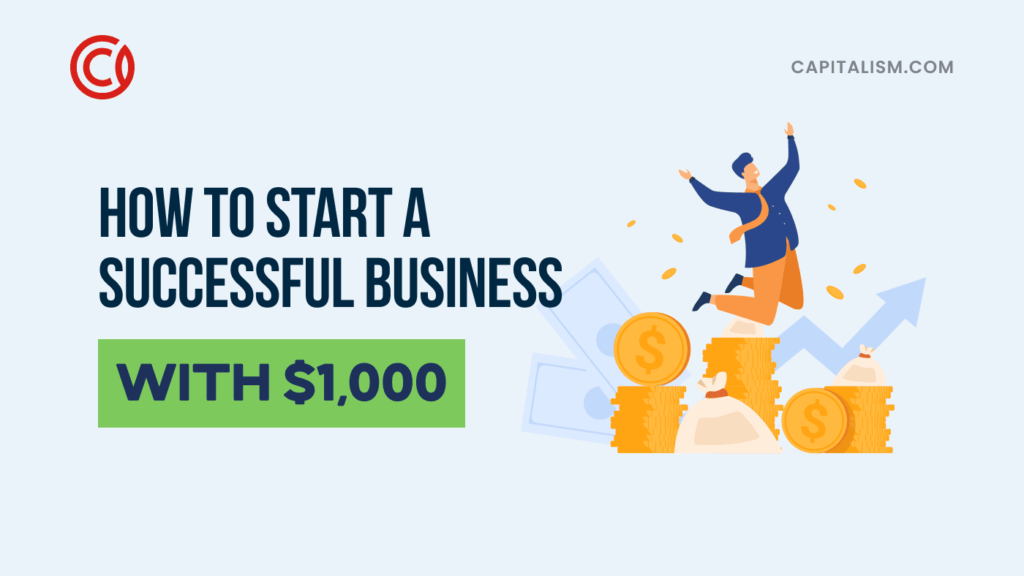Starting a business in the USA doesn’t have to cost a fortune. With less than $1,000, you can launch a successful venture if you plan smartly and use affordable tools. This guide will walk you through practical steps to start your own business on a tight budget. Whether you’re dreaming of an online store, a service-based business, or a side hustle, these tips will help you get started without breaking the bank.

Why Start a Business with a Small Budget?
Many people think starting a business requires thousands of dollars, but that’s not always true. In 2025, technology and digital tools make it easier than ever to launch a business with minimal investment. A low-budget startup lets you:
- Test your idea without risking too much money.
- Learn business skills as you grow.
- Reach customers quickly using online platforms.
According to the U.S. Small Business Administration, over 30 million small businesses operate in the USA, and many started with small budgets. With the right approach, you can join them.

Step 1: Choose a Low-Cost Business Idea
The first step is picking a business idea that fits your budget. Here are some affordable options:
- Freelance Services: Offer skills like writing, graphic design, or social media management. All you need is a computer and internet.
- Online Store: Sell handmade products, print-on-demand items, or dropshipping goods. Platforms like Etsy or Shopify have low startup costs.
- Consulting: Share your expertise in areas like marketing, finance, or fitness. You can start with just a website and business cards.
- Content Creation: Start a blog, YouTube channel, or podcast. These require minimal equipment, like a smartphone or microphone.
Focus on businesses that use your existing skills or resources to keep costs low.
Step 2: Create a Simple Business Plan
A business plan doesn’t have to be complicated. Write a one-page plan that outlines:
- Your business idea and target customers.
- How you’ll make money (e.g., selling products, offering services).
- Your budget and how you’ll spend your $1,000.
- Basic marketing ideas, like social media or word-of-mouth.
This plan will keep you focused and help you avoid wasting money. Tools like Canva offer free templates for business plans, saving you time and cash.
Step 3: Register Your Business on a Budget
To operate legally, you need to register your business. Costs vary by state, but here’s how to keep it affordable:
- Choose a Business Structure: A sole proprietorship or LLC is cheapest. Sole proprietorships often cost $0 to register, while LLC fees range from $40-$500, depending on the state.
- Get an EIN: An Employer Identification Number (EIN) is free from the IRS website. It’s like a Social Security number for your business.
- Check Local Permits: Some businesses need licenses or permits, which may cost $50-$100. Check your city or county website for details.
Use online services like LegalZoom or Incfile for affordable registration if you need help. They often have packages under $200.
Step 4: Build an Online Presence for Cheap
In 2025, every business needs an online presence. Luckily, you don’t need to spend much:
- Website: Use platforms like Wix, Squarespace, or WordPress. Basic plans start at $5-$15/month. Some offer free tiers to start.
- Domain Name: Buy a domain for $10-$20/year through Namecheap or GoDaddy.
- Social Media: Create free accounts on Instagram, TikTok, or LinkedIn to promote your business.
- Logo: Design a simple logo using free tools like Canva or Hatchful.
A professional-looking website and active social media can attract customers without expensive advertising.

Step 5: Market Your Business for Free or Low Cost
Marketing doesn’t have to be pricey. Try these budget-friendly ideas:
- Social Media Posts: Share engaging content, like behind-the-scenes photos or customer testimonials, to build a following.
- Email Marketing: Use free tools like Mailchimp to send newsletters to customers. Basic plans are free for up to 500 contacts.
- Networking: Join local business groups or online communities like Reddit or Facebook Groups to connect with potential clients.
- Collaborations: Partner with other small businesses to cross-promote your services.
Spending $50-$100 on targeted ads on platforms like Instagram or Google can also give you a quick boost.
Step 6: Manage Your $1,000 Budget Wisely
Here’s a sample breakdown of how to use your $1,000:
- Business registration and permits: $100-$300
- Website and domain: $50-$100
- Marketing (ads, business cards): $100-$200
- Tools or supplies (e.g., software, materials): $200-$400
- Emergency fund: $100-$200
Track your spending with free apps like Wave or QuickBooks to stay on budget.
Step 7: Leverage Free or Low-Cost Tools
Technology is your best friend when starting a business on a budget. Here are some tools to consider:
- Google Workspace: Free or low-cost email and document tools.
- Trello or Asana: Free project management apps to stay organized.
- Shopify or Etsy: Low-cost platforms for e-commerce, with fees as low as $1/month for starter plans.
- Fiverr: Hire freelancers for tasks like logo design or website setup for as little as $5.
These tools help you look professional without spending much.
Common Mistakes to Avoid
Starting a business is exciting, but avoid these pitfalls:
- Overspending Early: Don’t buy fancy equipment or office space until you’re profitable.
- Ignoring Customers: Listen to feedback to improve your product or service.
- Skipping Legal Steps: Registering your business protects you from legal issues.
- Giving Up Too Soon: Building a business takes time, so stay patient.
Success Stories to Inspire You
Many entrepreneurs started with less than $1,000 and succeeded:
- Spanx: Sara Blakely launched her shapewear brand with $5,000, mostly spent on a prototype and patent.
- Mailchimp: Ben Chestnut started the email marketing platform with a small budget, focusing on free marketing.
- Etsy Sellers: Thousands of Etsy shop owners began with under $500, selling handmade or vintage items.
These stories show that a small budget doesn’t limit your potential.
Final Tips for Success
Starting a business with less than $1,000 is possible if you stay resourceful. Focus on:
- Using free or low-cost tools to save money.
- Building a strong online presence to attract customers.
- Learning from mistakes and adapting quickly.
- Must Read :- Best Luxury Watches That Define Style in 2025





